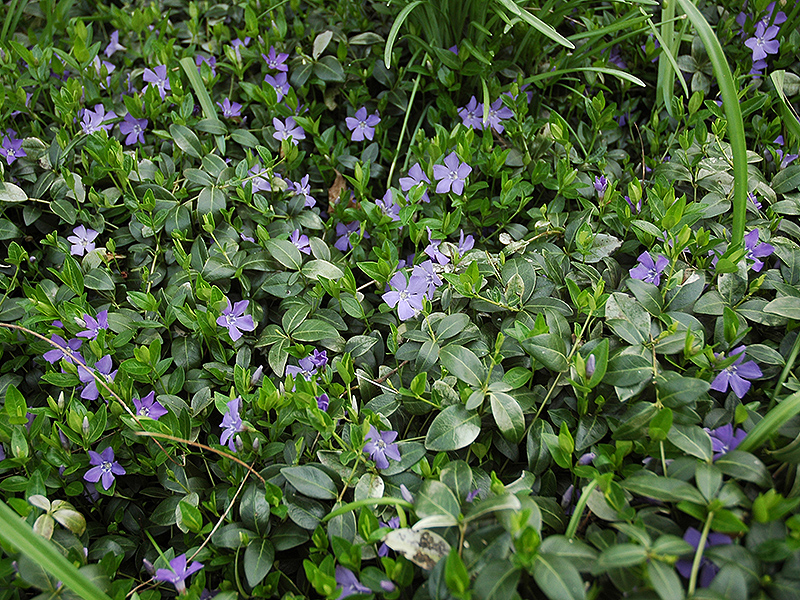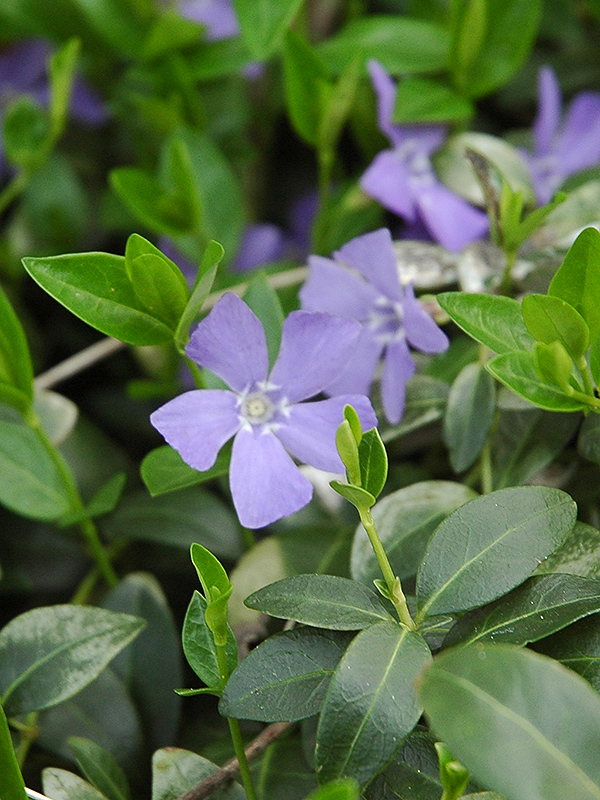
Perennials, Weeds > Vinca > Vinca minor > Vinca minor
Vinca minor
Common Periwinkle
Origin: The term Vinca translates “to bind” which refers to the stems hugging the ground. It is an ancient plant native to Central and Eastern Europe, Russia and the north Caucasus.

"
I once used this plant profusely and in fact visitors to the A.M. Cuddy Gardens in Strathroy may still see large planting beds of it under the famous Ulmus americana. It was used and still is by others today because it is a very effective groundcover, rapidly covering the area with an impenetrable mat. That said I have seen it spread into large woodland stands, suffocating the native flora. These escapees are often from gardens bordering on such natural areas or where people have dumped landscape debris and the clippings of Vinca have taken root. Some of the cultivars (often variegated forms) are less vigorous and may make ideal substitutes for the straight species. Use with caution, ideally in parking lot islands where escapees can be driven over.
Michael Pascoe, NDP., ODH., CLT., MSc. (Plant Conservation)
"
| Family |
| Apocynaceae |
| Genus |
| Vinca |
| Species |
| minor |
| Category |
| Perennials, Weeds |
| Pronunciation |
| USDA Hardiness Zone |
| 4 - 8 |
| Canadian Hardiness Zone |
| 2a - 8a |
| RHS Hardiness Zone |
| H7 - H4 |
| Temperature (°C) |
| (-32) - (-7) |
| Temperature (°F) |
| (-25) - 20 |
| Height |
| 7.5 - 16 cm |
| Spread |
| 2 m |
| General Description |
| Mat-forming creeper found in shady locations, often used as ground cover. Stays a evergreen under snow. Has a habit of growing further than its intended planting bed. |
| Landscape |
| Used for ground cover in moist, shady areas at foundations, planting beds, often seen under woody plants. Attractive spring blossoms. |
| Cultivation |
| Grows best in partial sun to full shade in moist, well-drained soils, and is adaptable to pH and drought. The foliage will become chlorotic in full sun and the plant may fail. |
| Shape |
| Mat-forming groundcover. |
| Growth |
| Medium |
| ID Characteristic |
| Blue/purple flowers in spring, shiny, elliptical evergreen leaves on trailing stems, rooting at the nodes. Often mistaken for Purple Wintercreeper which do not root nodally. |
| Pests |
| Phomopsis livella (dieback) can become a serious problem. |
| Habitat |
| Wide spreading, evergreen ground cover found in shady areas with moist, well-drained soils. |
| Bark/Stem Description |
| Non-woody stems which are slender (2 mm in diameter), light to dark green, smooth, and somewhat glabrous. |
| Flower/Leaf Bud Description |
| Buds appear in April after developing under the mat of foliage. Purplish, lanceolate buds, 1 cm long, on erect shoots. |
| Leaf Description |
| Elliptical, small (1-5 cm long) light to dark green leaves, in both a spiral and opposite leaf arrangement. |
| Flower Description |
| Solitary, perfect, purple flowers originate vertically from leaf axis and bloom from early spring to mid summer. Pinwheel formation, 12 cm in diameter with a five-lobed corolla. |
| Fruit Description |
| Often unnoticed, small follicle of brown fruit with no ornamental value. |
| Colour Description |
| Dark green on upper side of leaves, light green beneath. Vivid purple flowers. |
| Texture Description |
| Dense branching, soft leaves and a fine texture, comfortable to walk on. |
| Notable Specimens |
| The A.M. Cuddy Gardens, Strathroy, Ontario, Canada. |
| Propagation |
| Propagate by rooting semi-ripe stem cuttings in summer or crown division. |


